
The Gothic “Cruet” Church
Église St-Germain-l’Auxerrois
The Gothic church of St-Germain-l’Auxerrois is an unusual animal — not so much because of stylistic hybridity (mostly Gothic with Renaissances touches), but because the church seems to hold a mirror to itself.
Below, only the edifice circled in red is the Gothic church:
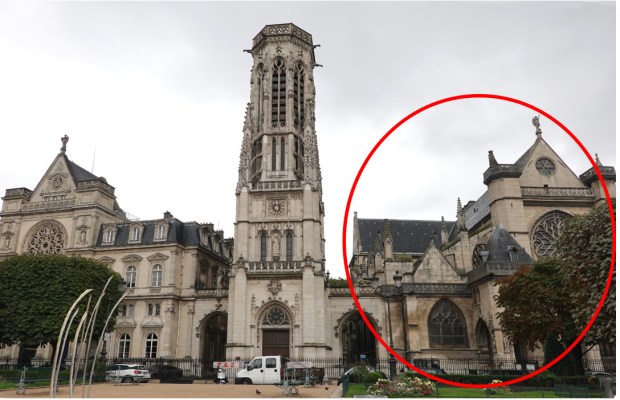
The Neo-Gothic tower and church-twin to the left are both Haussmann’s 19th-century additions. The building to the far left is actually the city hall of the 1st arrondissement — a mirror image of the Gothic church, but flanked by an office building (a dead giveaway for modernity).
Why did Haussmann append whole Neo-Gothic buildings to the authentically Gothic St-Germain-l’Auxerrois? Was it to confuse tourists who don’t know whether to go left or right to visit the church?
Actually, the answer involves a massacre of Protestants . . . but first, a look at the church itself.
Gorgeous Gothic interior
Considering how long it took to build the church, the interior is surprisingly consistent with its 13th-century Gothic beginnings. After the Hundred Years War interrupted the construction, the church was mostly completed during the 15th century.
The soaring Gothic choir:

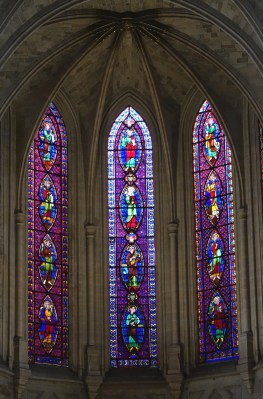
21st-century stained glass
The church also harbors a 21st century stained glass window:
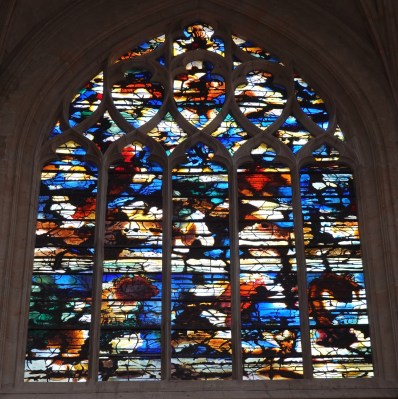
Saints, hell, apocalypse
The well-preserved carvings and statuary at the entrance, protected by a porch, reward a closer look. Above the doors is a traditional “arc of judgement,” and to the left and right of the doors are groups of remarkable medieval statuary.
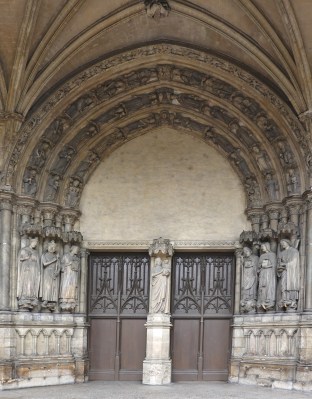
The arc of judgement::

At the top center of this arch are images from the Book of Revelation. I enjoy finding such representations. They appeal to my sense of the surreal. Plus — lots of action and drama. (I went to town with the rose window at Sainte Chapelle, which contains only scenes from Revelation.)
For example, in the detail below, the lower carving depicts events after the breaking of the Sixth Seal: the sun turned black and “the heaven departed as a scroll when it is rolled together.”

The upper carving? The ensuing Apocalypse: earthquakes collapse crenelated castles into jumbled ruins.
Below: The arc on the right side ends with a horrific image of hell. An enchained devil with cleft feet grins approvingly as a monkey-demon torments the damned. Three heads grimace in pain as they roast over a fire. Bosch-worthy.

The left side of the arc ends in a representation of the Trinity. The three smiling heads resting in the lap of unitary God counterbalance the three heads burning in hell.

Below, a closer look at the statues to the right of the portal. Saints and an angel sport archaic smiles . . .
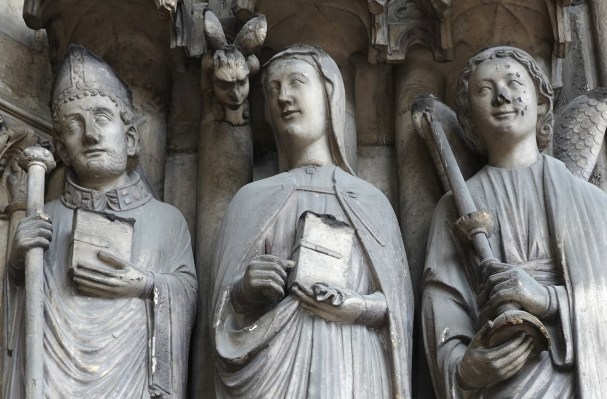
. . . as they trample demons and a damned soul underfoot:
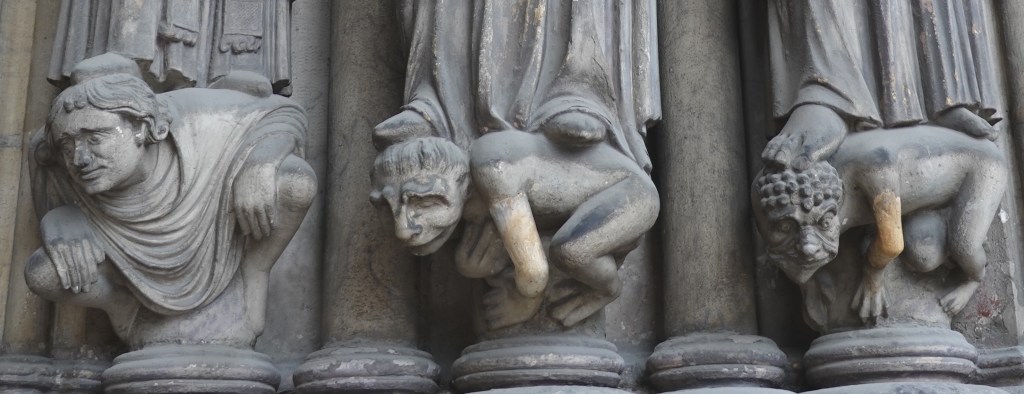
The arms of the demons have, it seems, been rubbed clean by visitors, perhaps making a wish as they do so.
The middle figure, Saint Genevieve, holds a candle in her right hand, which the demon peering over her shoulder tries to extinguish. The two present the very image of the self divided.

Fast forward to the 19th century. St-Germain-l’Auxerrois, heavily damaged by the French Revolution and by an 1831 political riot, was in sore need of restorations. Among other changes, artists were commissioned to create fresh decorations to the Chapel of the Virgin. Amaury Duval was commissioned to paint the fresco surrounding the stone sculpture of Virgin and Child:
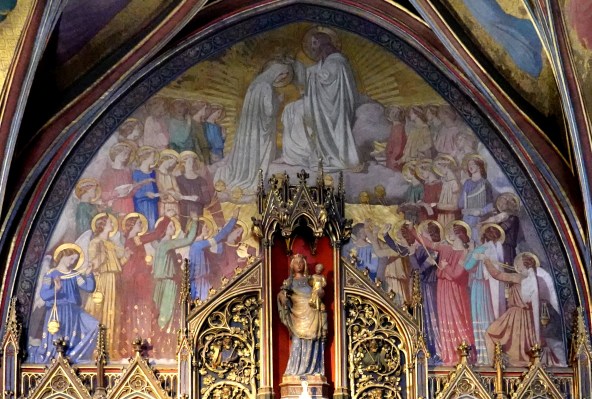
The gold background and halos suffuse the fresco with a Byzantine aura. Duval’s paintings inherited a quiet stillness from his teacher Ingres. Below: an angel, suspended for eternity within a space defined by the ribs of the vaulted ceiling.

Let’s return to the exterior for the story of the massacre and the cruet.
In spite of the church’s renovations earlier in the 19th century, St-Germain l’Auxerrois might well have fallen victim to Haussmann’s massive erasure of medieval Paris. Haussmann’s Protestantism played a part in the preservation of the Catholic church whose very bells had signaled the start of the 1572 St. Bartholomew’s Day Massacre of Huguenots by Catholic mobs. Haussmann didn’t want a legacy as the Protestant who razed the church to avenge its role in the massacre. Whatever Haussmann’s motivation, the church was spared when all around it, ramshackle buildings were flattened, opening up a vast space all the way to the Louvre.
To balance the church in relation to the newly empty space surrounding it, Haussmann commissioned the construction, adjacent to the church, of a neo-Gothic belfry and a town hall mirroring the church’s facade. Twins in their Gothic faces, the bureaucratic echos the ecclesiastical.

The symmetrical complex has earned a banal nickname: the “cruet.”
I can’t leave St-Germain-l’Auxerrois without having a peek at two altarpieces and a statue of Mary of Egypt that have found a home in the church. My apologies. I can at least promise crooked stairs and a preternaturally hirsute female saint.
Two Flemish altarpieces
The older altarpiece, carved from oak, displays highly ornate scenes packed with throngs of figures within a defined space. No nook or cranny is wasted in this claustrophobic world-unto-itself:
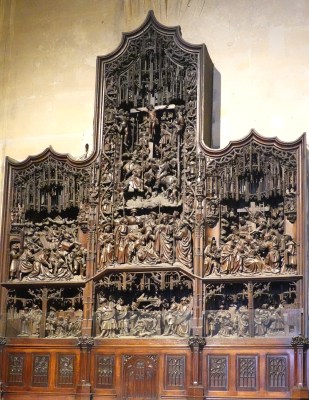
Detail, crucifixion scene:

The other Flemish altarpiece is a triptych whose outer wings display painted scenes of Eden and the Annunciation. The inner portion consists of carved and painted wood panels representing scenes from the life of the Virgin:

I was drawn to a carved scene that included a painting. The scene represents the ancient Jewish rites performed in the temple following childbirth: the purification of the mother (from the “contamination” associated with giving birth) and the presentation of the baby Jesus. The three women entering the temple bring a small cage, perhaps an offering of turtledoves.

The framed painting within the scene is a full-length portrait of a Jewish high priest wearing the official vestments characteristic of the time of Jesus:
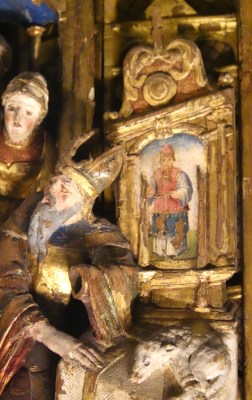
Around the neck of the high priest hangs a breastplate encrusted with precious stones:

Gold bells were sewn along the hem of his robe. When he entered and exited the temple, the tinkling bells became an amulet against death.
The high priest in the portrait is obviously Jewish. But the actual priest performing the rites for Mary and Jesus anachronistically wears a Christian bishop’s mitre.
Another blending of Jewish and Christian symbolism inheres in the lamb, toward which the bishop gestures:
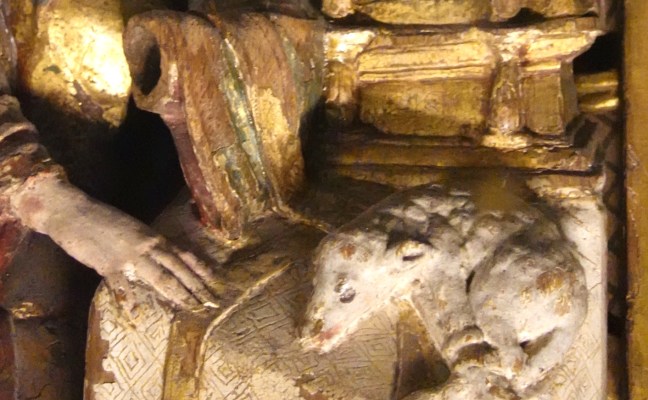
The Jewish rite of purification after childbirth might involve the sacrificial offering of a lamb. The parallel with Christian iconography is evident, bringing Old and New Testaments together in one symbolic image.
These carved scenes are more naturalistic than the jam-packed earlier Flemish altarpiece. Even so, there’s something a bit primitive about them, as in the presentation of Mary at the temple (below). The staircase was not given the benefit of perspective, and the upper treads tilt perilously to the right.

In his description of the church, Huysmans calls the stairs “amusing.”
Mary of Egypt
Below, a polychrome statue of a heavy-lidded Mary of Egypt. According to hagiographers, she was a prostitute (like Mary Magdalene, with whom she is sometimes conflated). Mary of Egypt converted to Christianity, embraced celibacy, walked into the Jordan desert with three loaves of bread, and became a hermit.

She’s often depicted naked (her clothes having worn away), sporting long hair or else displaying various stages of hirsutism. According to legend, animal-like fur miraculously grew to shield her nakedness. Mary of Egypt, her appearance transformed by the growth of a creaturely coat of fur, would not be out of place in Ovid’s Metamorphoses.
The sculpture is remarkable for the delicate rendition of her wavy golden hair cascading over her thighs. Artists sometimes blurred the line between depicting female saints as voluptuous versus venerable. A sexualized female saint might elicit steamy rather than spiritual thoughts in the viewer. Many a Madonna lactans offering her breast to the infant Jesus radiates eroticism.
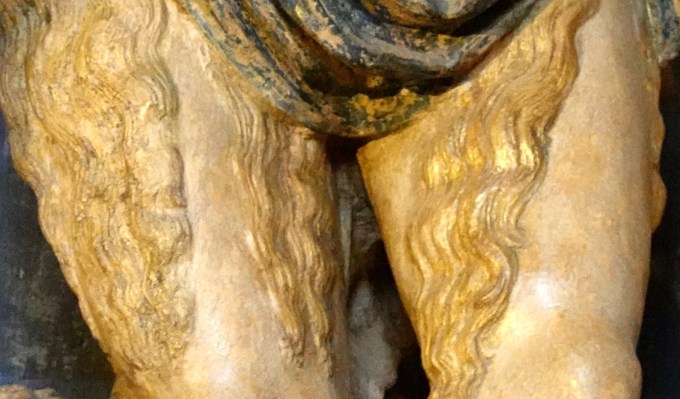
The sculptor of Mary of Egypt has it both ways. On the side of sensuality, he gives the hermit-saint a youthful face and blond Lady-Godiva hair/fur that caresses her body.
On side of modesty, her eyes are lowered chastely. A layer of her hair demurely covers her breasts. A cloth drapes protectively in rounded folds over her abdomen. And her swollen belly and stacked loaves of bread register fecundity, like wheat-bearing Demeter.

She is at once erotic and solemn; promiscuous and virginal; nubile and dry as the desert; a symbol of plenty with her stack of bread yet also of indigence, wandering through the barren wilderness.
A coda of fin-de-siècle ennui
To end this meditation on St-Germain-l’Auxerrois with a passage from Huysmans’ description of the church:
And we find ourselves, with this disgust at the beginning of the century, envying this good priest who interrupts himself from his work to wipe his horned glasses amid the great silence of these deaf stone walls broken only by the tired sighs of the wood.
J. K. Huysmans, Saint-Germain l’Auxerrois (1905)

Beatrice Guichard, Hautes Herbes (Tall Grass), a contemporary sculpture installed before the 19th-century neo-Gothic tower
Next: Sainte Chapelle — A Graphic Novel in Radiant Gothic
Camille Martin